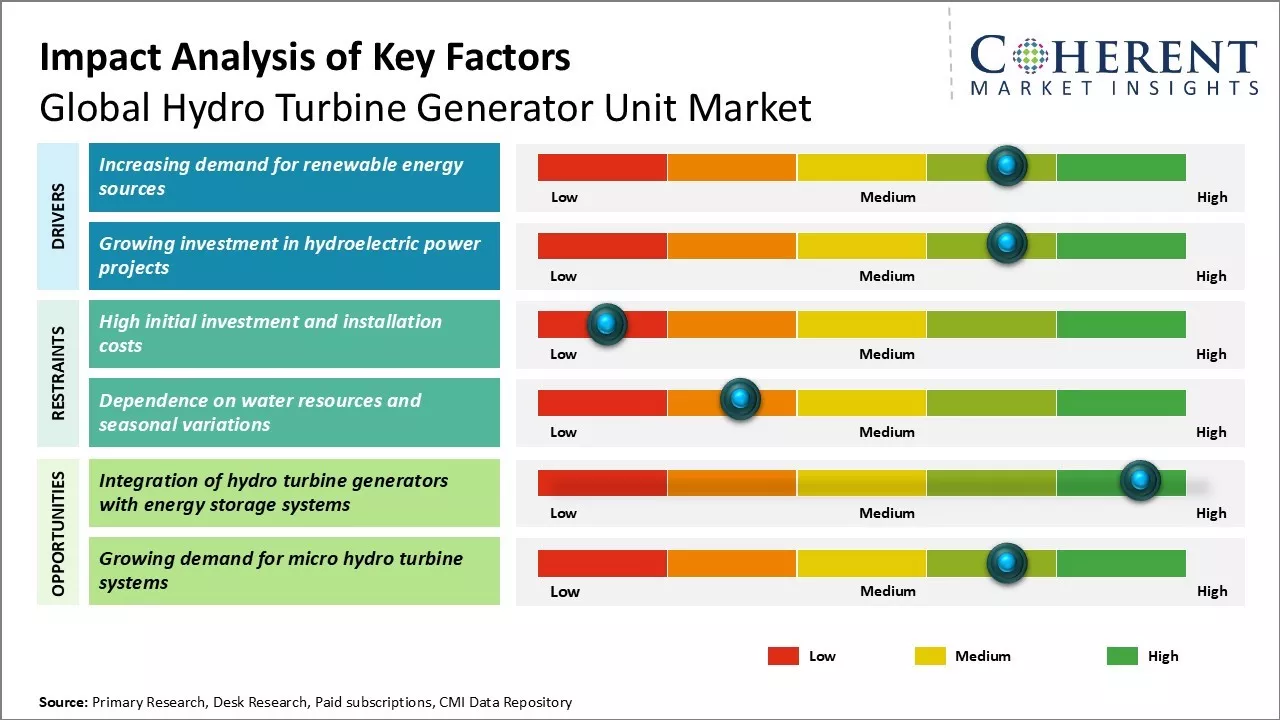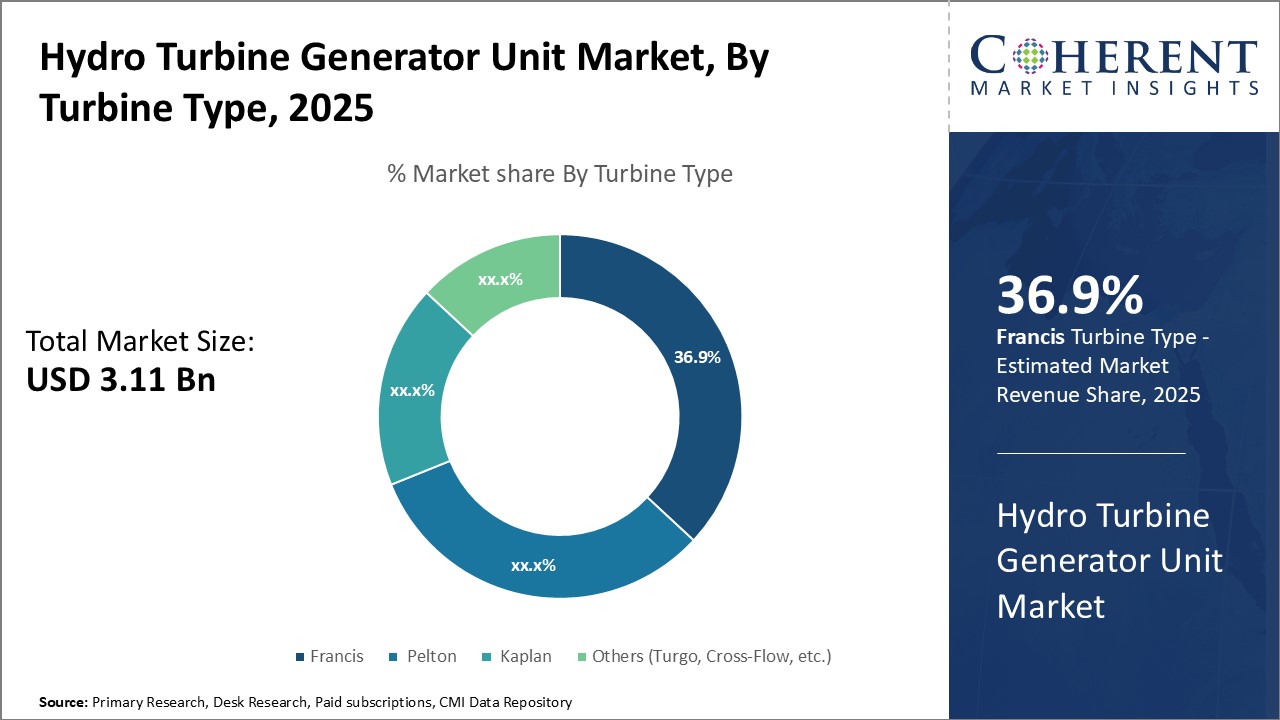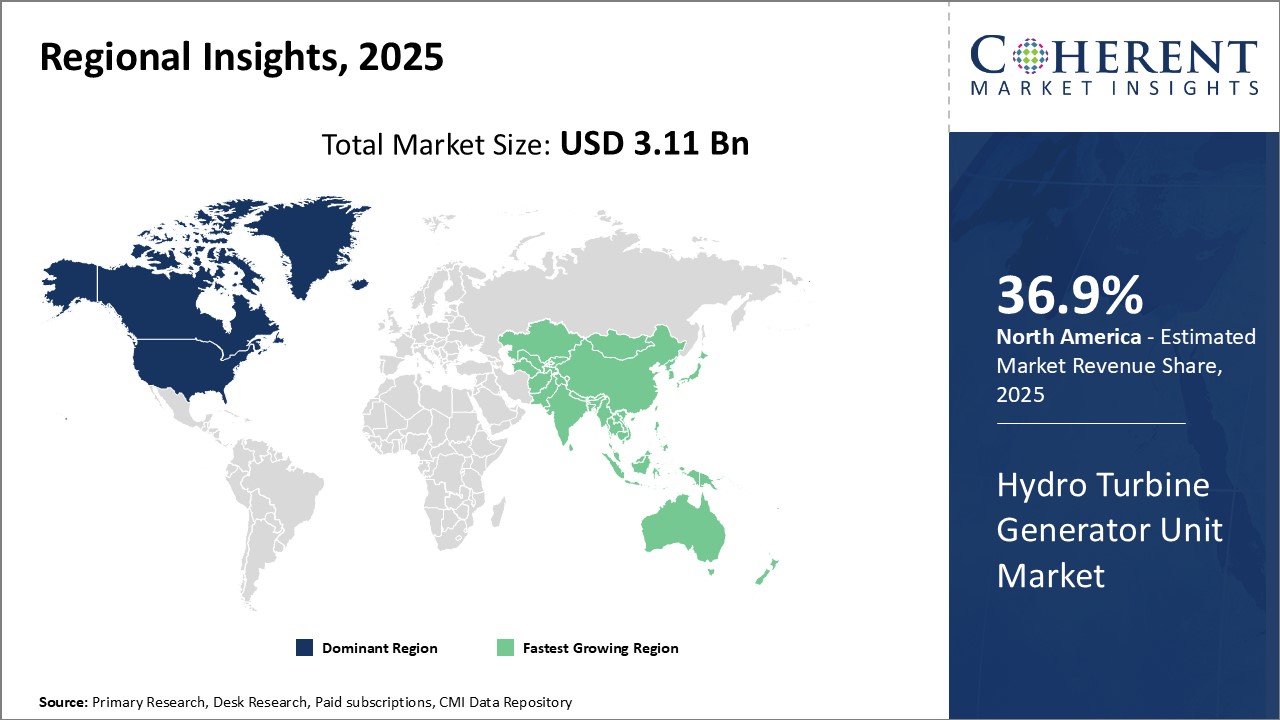
The Global Hydro Turbine Generator Unit Market is estimated to be valued at USD 3.11 Bn in 2025 and is expected to reach USD 4.24 Bn by 2032, exhibiting a compound annual growth rate (CAGR) of 4.5% from 2025 to 2032.

Discover market dynamics shaping the industry: Download Free Sample
With increasing investments in renewable energy sources across the world, the hydropower generation capacity is rising globally. Many countries are shifting their focus from fossil fuels to hydro power for producing clean energy, which is driving the growth of the hydro turbine generator unit market.
Market Driver - Increasing demand for renewable energy sources
The global energy mix is undergoing a massive transition towards more sustainable sources of energy generation as environmental concerns regarding carbon emissions and climate change become ever more pressing. Governments and regulatory bodies across major economies have been implementing supportive policies and incentives to boost the adoption of renewable power sources like solar, wind and hydro. Hydroelectric power, being a clean and reliable renewable, has seen resurgent interest from both public and private sector stakeholders looking to reduce their carbon footprint.
However, there is now a discernible shift where more countries are prioritizing their long-term energy security through indigenous renewable resources like hydro. Several nations have abundant potential for hydro development due to their geography and climate conditions. Harnessing this native renewable source allows them to meet escalating power needs while also furthering environmental and climate goals. This has led to ambitious targets being charted for increasing the share of hydro and other renewables in the overall energy mix over the coming years.
Achieving these renewable energy targets will require massive investments and deployment of necessary infrastructure. Setting up large-scale hydropower projects involving complex civil works and specialized elect mechanical equipment demands heavy machinery. Hydro turbine generator units form the core technology enabling efficient power generation from kinetic energy of flowing water. With more dams and hydropower plants in the pipeline across geographies, manufacturers of these critical powerhouse components are poised for significant business opportunities. The rising global demand for hydroelectric solutions is thus driving corresponding growth in the market for hydro turbine generator units to facilitate expanded renewable capacity additions.

Get actionable strategies to beat competition: Download Free Sample
Growing Investment in Hydroelectric Power Projects
The urgent need to transition away from carbon-intensive fuels and curtail emissions is bringing massive private capital into clean energy sector. Several studies have indicated that hydropower, if tapped to its full potential, can meet a substantial portion of rising power demand while offering reliability and resilience. This has galvanized both governments and major corporations to invest heavily in scaling up hydro capacities around the world. Multi-billion-dollar investments are being made to undertake big hydropower developments featuring advanced technologies.
Countries with hydro endowments are leveraging public-private partnerships and offering different incentive structures to attract institutional and impact investors towards hydropower ventures. International developmental organizations and climate finance instruments are also catalyzing investment flows into building new run-of-river and storage-type hydropower stations. Mega hydropower complexes combining power generation, irrigation and flood controls are being constructed. Small-scale mini and micro-hydel projects are equally gaining ground due to modular capabilities and shorter timelines for implementation.
Each new hydro project signifies increased installed base for hydraulic turbines and generators to power water wheels involved. Project developers and power producers therefore remain keen buyers for hydro turbine generator units required across the full project lifecycle from initial infrastructure laying to long-term O&M needs. With more capital being unlocked and allocated to the hydropower sector worldwide, equipment manufacturers stand to gain significantly as suppliers of choice. Steady rise in investment commitments towards hydro facilities thus fosters parallel growth of the turbine generator market to equip these emerging renewable energy assets.
Key Takeaways from Analyst:
The rising concerns regarding environmental pollution and the need to reduce dependence on fossil fuels will drive many countries to focus on renewable sources of energy like hydro power. The large untapped hydropower potential in developing nations of Asia Pacific and Latin America provide huge opportunities for market players in the hydro turbine generator unit industry. China, as the world's largest investor in renewable power capacity, will be a key market for hydro turbine equipment providers.
However, factors such as high initial investment costs and lengthy approval processes for hydropower projects pose challenges to the market's growth trajectory. Established markets like North America have limited room for new dam-based hydropower plants. Changing environmental regulations regarding construction near rivers and dams could also act as a restraint. The market is quite consolidated with a few big players dominating the market. Access to new emerging markets will be critical for leading vendors to sustain high growth rates.
In the coming years, development of innovative turbine designs capable of operating under low head conditions can disrupt the market. Adoption of smart grid solutions and demand for ancillary services from hydropower stations indicate new revenue streams. Replacement of aging equipment at old hydropower facilities provides steady aftermarket opportunities.
Market Challenge - High initial investment and installation costs
One of the major challenges faced by the global hydro turbine generator unit market is the high initial investment and installation costs associated with setting up a new hydroelectric power project. Developing hydroelectric power requires substantial capital expenditure from the start for activities such as feasibility studies, land acquisition, infrastructure development, constructing dams and tunnels, and installing complex turbine and generator units. The high costs involved in civil works such as building concrete dams and diverting water channels over rugged terrains significantly drive-up total project costs. Additionally, various environment impact assessment studies and approval procedures before commencing construction further inflate the initial investment needs. These high entry costs pose serious budgeting challenges for both private developers and government agencies, especially in developing nations with limited financial resources. Moreover, the remote nature of many potential hydroelectric sites leads to higher transportation and logistical costs for shipping large turbine and generator components to project locations. These increased initial costs serve as a deterrent for scaling up investments in hydropower capacity additions globally.
Opportunity: Integration of Hydro Turbine Generators with Energy Storage Systems
One major opportunity for the global hydro turbine generator unit market is the integration of these systems with large-scale energy storage technologies. Pairing hydroelectric projects with energy storage solutions such as pumped hydro storage and battery systems allows dam operators to time-shift generation and store excess power produced during off-peak hours for reuse when electricity demand is high. This enables hydro plants to participate in broader ancillary services markets for load balancing and peak shaving, thereby enhancing overall power plant revenues. Storage technologies also help address the intermittency issues inherent to variable renewable sources like solar and wind, providing hydro generators with new revenue streams from ancillary grid support services. The synergies between hydroelectricity and energy storage could thus promote further uptake of integrated hydropower-plus-storage projects worldwide. Leading turbine manufacturers are already partnering with storage developers to offer customized solutions maximizing the benefits of this convergence. Widespread adoption of such hybrid energy systems bodes well for future demand of hydro turbine generator units.

Discover high revenue pocket segments and roadmap to it: Download Free Sample
Insights by Turbine Type - Proven Performance Propels Francis Turbines to the Forefront
Francis turbines are projected to capture a 36.9% share of the hydro turbine market in 2025, largely due to their reliability across a broad spectrum of operational heads and flows. These turbines are particularly effective in medium to high head applications, ranging from 30 to 1000 meters, making them the predominant choice for existing hydroelectric facilities globally.
The design of Francis turbines allows for efficient energy generation under varying load conditions, whether partial or full. They exhibit lower internal stresses compared to other inward-flow turbine types, such as Kaplan turbines, which translates to reduced wear and lower maintenance costs throughout their operational lifespan. Recent advancements in manufacturing have enhanced the durability of key components, enabling them to withstand significant pressure and vibration, thereby extending their service life.
Operational data indicates that Francis turbines often achieve availability factors exceeding 95%. Their outward flow design facilitates the efficient removal of air and sediment from the water, protecting the internal runner blades from potential damage during high-silt conditions or flooding. This adaptability allows engineers to optimize hydraulic designs to suit diverse site conditions, and their modular construction supports straightforward installation and the potential for future expansion.
Leading manufacturers have consistently refined Francis turbine designs, incorporating new materials and digital monitoring technologies. Innovations such as predictive maintenance, which leverage sensors and data analytics, proactively address potential issues, enhancing overall plant efficiency and minimizing unplanned outages. The extensive operational history and continuous improvements have established Francis turbines as the preferred choice for large-scale hydropower projects worldwide.
Insights by Generator Type - Synchronous Generators Dominate with Grid Synchronization Advantage
Synchronous generators are projected to capture a 73% share of the hydro turbine market in 2025, primarily due to their inherent ability to maintain synchronization with the power grid frequency. These generators contain a rotor winding that is electrically excited to generate a rotating magnetic field at the same speed as the grid frequency, typically 50 or 60 Hertz. This synchronization enables synchronous generators to instantly and accurately control the voltage level, phase, and frequency of the power fed into the grid.
Utilities highly value this level of grid compatibility as it ensures stability of the transmission and distribution network. Synchronous generators can instantly respond to fluctuations in demand to prevent power outages or blackouts. They can also contribute reactive power support through automatic voltage regulation without any external excitation controls, helping to regulate the grid voltage during both normal and transient operating conditions.
Moreover, synchronous generators allow for flexible controllability through governor systems linked to the water turbines. Operators can precisely control real and reactive power output within milliseconds to handle intermittent renewable generation and changing load profiles on the grid. As a result, synchronous generators remain the standard technology at large hydroelectric stations to reliably meet grid code requirements.
Insights by Head Range - Efficiency Advantages Drive Low Head Hydro Development
The low head (< 100 meters) segment of the hydro turbine market is anticipated to account for 42.2% of the market share in 2025, driven by the potential to efficiently harness untapped river stretches and reservoir edges. Lower head applications significantly reduce the civil works and construction costs associated with diversion structures, intake channels, and pipelines. This segment also benefits from a wider selection of turbine designs optimized for low head conditions, such as bulb turbines and vertical Kaplan turbines.
Hydraulic efficiency is critical at low heads, and modern hydro turbines are engineered to achieve high efficiencies even at partial loads. Innovations like adjustable blade angles and advanced operating zones enhance performance, while digital governing systems ensure that turbine operations continuously align with the optimal efficiency point, minimizing water spillage. Additionally, new surface aerators can aerate water without the need for spillways, improving downstream oxygen levels.
Developers are increasingly implementing run-of-river hydropower schemes at low heads, which do not require large reservoirs, addressing local environmental concerns. These projects typically channel sections of natural river flows through underground pipes to powerhouses located near existing infrastructure, facilitating easier access and reduced environmental impact. Modular designs allow for the straightforward installation and removal of small hydro units with capacities below 10 MW.
The combination of efficient technologies, streamlined designs, and flexible implementation models has positioned low head hydropower as a competitive alternative to conventional energy sources, driving sustained growth in this segment, particularly in regions with extensive river networks.

Need a Different Region or Segment? Download Free Sample
North America has established itself as the dominant region in the global hydro turbine generator unit market. With United States and Canada having large hydroelectric power generation capacities, there is a significant demand for new hydro turbine generator units as well as replacement of existing ageing units. Major global players in hydro turbine manufacturing such as GE Renewable Energy, Andritz, Voith, Toshiba, and Harbin have large production and servicing facilities spread across United States and Canada catering to the needs of local power projects. Moreover, both countries have stringent norms around usage of renewable sources for power generation which has further boosted the development of hydropower plants over last decade. With continuous investments in upgrading hydropower infrastructure, the region is expected to continue dominating the global market.
Among growing regions, Asia Pacific is emerging as the fastest growing regional market for hydro turbine generator units. Countries like China, India and Southeast Asian nations are investments heavily in expanding their renewable power generation capacities including large, small and micro hydropower projects. China with its ambitious target of achieving over 300 GW of hydro installed capacity by 2030 and investment plans of over US$ 150 Billion is driving most of the demand. Whereas India has set a goal of adding 5 GW annual hydropower capacity taking the total to 66 GW by 2027. This rapid capacity addition is attracting component manufacturing companies to set up localized manufacturing units to cater to the projected rise in demand. In addition, economical labor and availability of raw materials in countries like China is supporting their prominence in turbine exports. The favorable policy push and massive planned investments make Asia Pacific the most lucrative regional market for long term growth.
Hydro Turbine Generator Unit Market Report Coverage
| Report Coverage | Details | ||
|---|---|---|---|
| Base Year: | 2024 | Market Size in 2025: | USD 3.11 Bn |
| Historical Data for: | 2020 To 2024 | Forecast Period: | 2025 To 2032 |
| Forecast Period 2025 to 2032 CAGR: | 4.5% | 2032 Value Projection: | USD 4.24 Bn |
| Geographies covered: |
|
||
| Segments covered: |
|
||
| Companies covered: |
Andritz AG, Canyon Hydro, Cornell Pump Co., GE (General Electric Company), Gilbert Gilkes & Gordon Ltd., Harbin Electric Machinery, Kirloskar Brothers Ltd., Siemens AG, Toshiba Energy, and WWS Wasserkraft GmbH |
||
| Growth Drivers: |
|
||
| Restraints & Challenges: |
|
||
Uncover macros and micros vetted on 75+ parameters: Get instant access to report
Share
Share
About Author
Ramprasad Bhute is a Senior Research Consultant with over 6 years of experience in market research and business consulting. He manages consulting and market research projects centered on go-to-market strategy, opportunity analysis, competitive landscape, and market size estimation and forecasting. He also advises clients on identifying and targeting absolute opportunities to penetrate untapped markets.
Missing comfort of reading report in your local language? Find your preferred language :
Transform your Strategy with Exclusive Trending Reports :
Frequently Asked Questions
Joining thousands of companies around the world committed to making the Excellent Business Solutions.
View All Our Clients